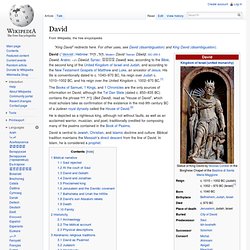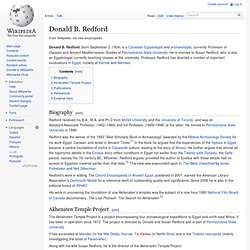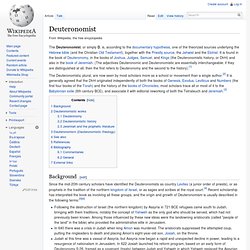

Convergence and Differentiation. David. The Books of Samuel, 1 Kings, and 1 Chronicles are the only sources of information on David, although the Tel Dan Stele (dated c. 850–835 BC) contains the phrase בית דוד (Beit David), read as "House of David", which most scholars take as confirmation of the existence in the mid-9th century BC of a Judean royal dynasty called the House of David.

He is depicted as a righteous king, although not without faults, as well as an acclaimed warrior, musician, and poet, traditionally credited for composing many of the psalms contained in the Book of Psalms. David is central to Jewish, Christian, and Islamic doctrine and culture. Biblical tradition maintains the Messiah's direct descent from the line of David. In Islam, he is considered a prophet. Biblical narrative[edit] Young David holds the impaled head of Goliath and marches before a general on a white horse, as envisioned by Poussin, ca. 1632 Saul rejected[edit]
Baruch Halpern. Baruch Halpern is the Covenant Foundation Professor of Jewish Studies at the University of Georgia.

He was a leader of the archaeological digs at Tel Megiddo 1992-2007.[1] As an undergraduate at Harvard in 1972, he wrote a political analysis of the Bible, which subsequently influenced research into its authorship. [2] Major publications include: Thomas L. Thompson. Thomas L.

Thompson (born January 7, 1939 in Detroit Michigan) is a biblical scholar and theologian. He was professor of theology at the University of Copenhagen from 1993–2009, lives in Denmark and is now a Danish citizen. Biography[edit] Thompson was raised as a Catholic and obtained a B.A. from Duquesne University, Pittsburgh, Pennsylvania, USA, in 1962. He was instructor in theology at Dayton University (1964–65) and Assistant Professor in Old Testament studies the University of Detroit (1967–69). He taught at Lawrence University (visiting associate professor, 1988–89) and at Marquette University (associate professor 1989–93), but did not receive tenure despite the international reputation of his research, something Thompson blames on conservative Catholics in the faculty under the influence of Ratzinger.
Thompson was named a National Endowment for the Humanities Fellow in 1988. Old Testament writings[edit] New Testament writings[edit] Books[edit] Thompson, Thomas L. (1974). Donald_B. Donald B.

Redford (born September 2, 1934) is a Canadian Egyptologist and archaeologist, currently Professor of Classics and Ancient Mediterranean Studies at Pennsylvania State University. He is married to Susan Redford, who is also an Egyptologist currently teaching classes at the university. Professor Redford has directed a number of important excavations in Egypt, notably at Karnak and Mendes. Biography[edit] Redford received his B.A., M.A. and Ph.D from McGill University and the University of Toronto, and was an Assistant/Associate Professor (1962–1969) and full Professor (1969–1998) at the latter. Martin Noth. Martin Noth (August 3, 1902 – May 30, 1968) was a German scholar of the Hebrew Bible who specialized in the pre-Exilic history of the Hebrews.

With Gerhard von Rad he pioneered the traditional-historical approach to biblical studies, emphasising the role of oral traditions in the formation of the biblical texts. Life[edit] Noth was born in Dresden, Kingdom of Saxony. He studied at the universities of Erlangen, Rostock,[1] and Leipzig and taught at Greifswald and Königsberg. From 1939-41 and 1943–45, Noth served as a soldier during World War II. Influence[edit] Noth first attracted widespread attention with "Das System der zwölf Stämme Israels" (“The Scheme of the Twelve Tribes of Israel”, 1930), positing that the Twelve Tribes of Israel did not exist prior to the covenant assembly at Shechem described in the book of Joshua.
The Bible Unearthed. The Bible Unearthed: Archaeology's New Vision of Ancient Israel and the Origin of Its Sacred Texts[1] is a 2001 book about the archaeology of Israel and its relationship to the origins of the Hebrew Bible.

The authors are Israel Finkelstein, Professor of Archaeology at Tel Aviv University, and Neil Asher Silberman, a contributing editor to Archaeology Magazine. Methodology[edit] The methodology applied by the authors is basically historical criticism with an emphasis on archaeology. The Bible Unearthed 1. The Patriarchs. Historical criticism. Historical criticism, also known as the historical-critical method or higher criticism, is a branch of literary criticism that investigates the origins of ancient text in order to understand "the world behind the text".[1] The primary goal of historical criticism is to ascertain the text's primitive or original meaning in its original historical context and its literal sense or sensus literalis historicus.

Documentary hypothesis. Deuteronomist. The Deuteronomist, or simply D, is, according to the documentary hypothesis, one of the theorized sources underlying the Hebrew bible (and the Christian Old Testament), together with the Priestly source, the Jahwist and the Elohist.

It is found in the book of Deuteronomy, in the books of Joshua, Judges, Samuel, and Kings (the Deuteronomistic history, or DtrH) and also in the book of Jeremiah. (The adjectives Deuteronomic and Deuteronomistic are essentially interchangeable: if they are distinguished at all, then the first refers to Deuteronomy and the second to the history).[1] Background[edit] Following the destruction of Israel (the northern kingdom) by Assyria in 721 BCE refugees came south to Judah, bringing with them traditions, notably the concept of Yahweh as the only god who should be served, which had not previously been known.
Deuteronomistic works[edit] Jahwist. The Jahwist, or Yahwist, often abbreviated J in exegetical discourse, is the proposed source of the Jahwistic (Yahwistic) traditions of the Pentateuch (Torah).

It gets its name from the fact that it characteristically uses the term Yahweh (German Javeh, Hebrew YHWH) for God in the book of Genesis. During most of the 20th century the dominant belief among scholars was that the Torah had been composed by intertwining four originally separate and complete documents, of which the Yahwist was one—this was called the documentary hypothesis. In the last quarter of the 20th century the consensus over the documentary hypothesis unravelled, and although it still has supporters there are now many alternatives. These alternatives can be broadly divided between "fragmentary" and "supplementary" models (hypotheses). Background[edit] Characteristics[edit] J has a particular fascination for traditions concerning Judah, including its relationship with its neighbour Edom.
Michael D. Elohist. Background[edit] Modern scholars agree that separate sources and multiple authors underlie the Pentateuch, but there is much disagreement on how these sources were used to write the first five books of the bible.[4] The explanation called the documentary hypothesis dominated much of the 20th century, but the 20th-century consensus surrounding this hypothesis has now broken down.

Those who uphold it now tend to do so in a strongly modified form, giving a much larger role to the redactors (editors), who are now seen as adding much material of their own rather than as simply passive combiners of documents.[5] Among those who reject the documentary approach altogether, the most significant revisions have been to combine E with J as a single source, and to see the Priestly source as a series of editorial revisions to that text.[6] The alternatives to the documentary approach can be broadly divided between "fragmentary" and "supplementary" theories.
Priestly source.